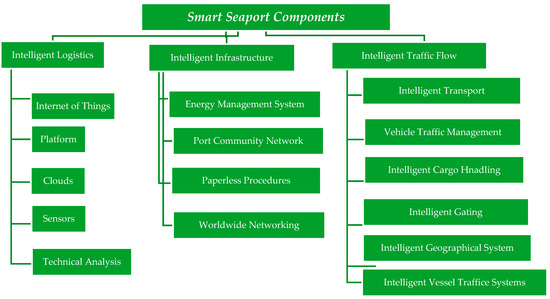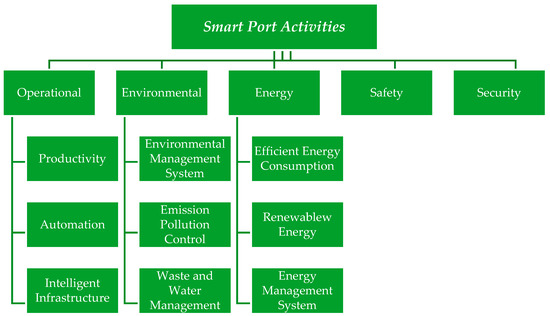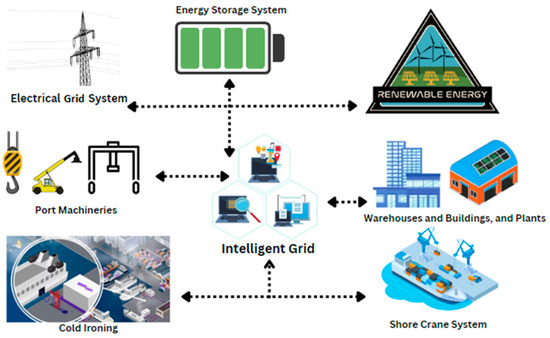
| Version | Summary | Created by | Modification | Content Size | Created at | Operation |
|---|---|---|---|---|---|---|
| 1 | Behbood Issa-Zadeh | -- | 2513 | 2023-12-05 14:38:47 | | | |
| 2 | Sirius Huang | -1 word(s) | 2512 | 2023-12-06 01:59:43 | | |
Video Upload Options
To lessen the environmental impact of the maritime industry, ports must decarbonize in conformity with various standards such as the European Green Deal and the Sustainable Development Goals (SDGs). In this regard, they must demonstrate integrated low-emission energy production, distribution, and supply, as well as sustainable alternative infrastructure for refueling ships, cargo handling equipment, and other vehicles inside port boundaries. To address this issue, ports must progress toward smartening their operations. This requires intelligent infrastructure and components, with smart energy infrastructure being one of the most crucial ones. It is a part of port energy management systems (EMSs) and works based on modern technology to balance energy demand, distributions, and supply while transitioning to renewable energies.
1. Introduction
2. Smart Seaport Components


3. Smart Port Activities

- (i)
-
Operation;
- (ii)
-
Environment;
- (iii)
-
Energy;
- (iv)
-
Safety;
- (v)
-
Security.
-
Operation. The operation can be categorized as follows:
- (a)
-
Productivity: this may be represented by balancing needs and providing essential port services, such as cargo loading and unloading, cargo movement inside the port, traffic density management, and port clearance operations [10].
- (b)
-
Automation: under their supervision, different techniques for replacing human labor with automation may improve service effectiveness and reduce waiting times [11].
- (c)
-
Intelligent infrastructure: this refers to utilizing an intelligent port’s departments, capable of intelligent collaboration via intelligent communication and IoT [1].
-
Environment. The following categories apply to the environment:
- (a)
-
Environmental management system: this domain may be used to demonstrate any action that helps port activities fit with managing environmental protection [2].
- (b)
-
Emission and pollution control: this refers to any national and international regulations-compliant actions taken to reduce and control emissions within the port territory under the supervision of port authorities or public authorities [7].
- (c)
-
Waste and water management: this comprises all actions for balancing supply and demand for the management of water, a resource that is essential to the planet, and then goes to managing and accepting waste materials and then utilizing them, if possible, for other sectors like renewable energy [12].
-
Energy. This can be divided into:
- (a)
-
Efficient energy consumption: to achieve optimal energy consumption in seaports, there are several guidelines and international and national rules relating to the efficient energy usage of ships, vehicles, equipment, buildings, industries, and generators [13].
- (b)
-
Renewable energies and their production: Preparing renewable energy sources for use at seaports, such as wind, solar, earth thermal, and marine energy, is the second stage in minimizing the usage of fossil fuels. This might be one of the main objectives of smart seaport authorities and policymakers [14].
- (c)
-
Energy management: all tasks and duties the port authorities have to do with creating port-wide plans for energy efficiency and other relevant things [2].
-
Safety. In smart seaports with intelligent infrastructure, all port safety operations must be monitored [15].
-
Security. The term “smart port security activities” refers to all programs, projects, and seaport security operations that demand sophisticated infrastructure, technology, and oversight [16][17]. And now, with the deployment of artificial intelligence (AI) and intelligent energy network systems for smartly enhancing and controlling ports, cyber security is one of the most essential operations in the field of port security [18].
4. Smart Port Management

- -
-
All vessels in the port area may have vessel traffic management (VTM), vessel traffic management services (VTMSs), pilotage operation, and other maritime services managed by intelligent vessel management.
- -
-
Intelligent infrastructure and equipment may offer an intelligent cargo handling management system, including all loading, discharging, moving, and stripping storage in or out of a smart port.
- -
-
Intelligent port management uses cutting-edge decision-making processes, intelligent automation systems, and application systems for all choices, policies, and procedures.
- -
-
Intelligent energy management includes balancing energy supply and demand within the port, controlling efficient energy usage, and switching from fossil fuels to renewable and green energy sources.
5. Energy Management System

6. Energy Intelligence Network

7. Virtual Power Plant
8. Information and Communication Technology
References
- Spangler, W.S.; Kreulen, J.T.; Chen, Y.; Proctor, L.; Alba, A.; Lelescu, A.; Behal, A. A smarter process for sensing the information space. IBM J. Res. Dev. 2010, 54, 1–13.
- Lacalle, I.; Belsa, A.; Vaño, R.; Palau, C.E. Framework and Methodology for Establishing Port-City Policies Based on Real-Time Composite Indicators and IoT: A Practical Use-Case. Sensors 2020, 20, 4131.
- UNESCO; Bernard, C. Smart Cities: Shaping the Society of 2030; UNESCO: Paris, France, 2019. Available online: https://unesdoc.unesco.org/ark:/48223/pf0000367762 (accessed on 8 September 2023).
- Braverman, J.; Todosow, H. The Vision of a Smart City. 2000. Available online: https://www.researchgate.net/publication/241977644 (accessed on 8 September 2023).
- Min, H. Developing a smart port architecture and essential elements in the era of Industry. Marit. Econ. Logist. 2022, 24, 189–207.
- Pham, T.Y. A smart port development: Systematic literature and bibliometric analysis. Asian J. Shipp. Logist. 2023, 39, 57–62.
- Othman, A.; El-Gazzar, S.; Knez, M. A Framework for Adopting a Sustainable Smart Sea Port Index. Sustainability 2022, 14, 4551.
- Makkawan, K.; Muangpan, T. A conceptual model of smart port performance and smart port indicators in Thailand. J. Int. Logist. Trade 2021, 19, 133–146.
- Garay-Rondero, C.L.; Martinez-Flores, J.L.; Smith, N.R.; Morales, S.O.C.; Aldrette-Malacara, A. Digital supply chain model in Industry 4.0. J. Manuf. Technol. Manag. 2020, 31, 887–933.
- Lamberti, T.; Sorce, A.; Di Fresco, L.; Barberis, S. Smart port: Exploiting renewable energy and storage potential of moored boats. In Proceedings of the MTS/IEEE OCEANS 2015-Genova: Discovering Sustainable Ocean Energy for a New World, Genova, Italy, 18–21 May 2015.
- Battino, S.; del Mar Muñoz Leonisio, M. Smart Ports from Theory to Practice: A Review of Sustainability Indicators. In Proceedings of the Computational Science and Its Applications—ICCSA 2022 Workshops, Malaga, Spain, 4–7 July 2022; Lecture Notes in Computer Science. Springer: Berlin/Heidelberg, Germany, 2022; pp. 185–195.
- Lin, S.C.; Chang, H.K.; Chung, Y.F. Exploring the Impact of Different Port Governances on Smart Port Development Strategy in Taiwan and Spain. Sustainability 2022, 14, 9158.
- Fahdi, S.; Elkhechafi, M.; Hachimi, H. Green Port in Blue Ocean. In Proceedings of the 2019 International Conference on Optimization and Applications, ICOA 2019, Kenitra, Morocco, 25–26 April 2019.
- Arena, F.; Malara, G.; Musolino, G.; Rindone, C.; Romolo, A.; Vitetta, A. From green energy to green logistics: A pilot study in an Italian port area. Transp. Res. Procedia 2018, 30, 111–118.
- Yau, K.L.A.; Peng, S.; Qadir, J.; Low, Y.C.; Ling, M.H. Towards Smart Port Infrastructures. IEEE Access 2020, 8, 83387–83404.
- Securing Maritime Activities through Risk-based Targeting for Port Security Act. Available online: https://www.gop.gov/bill/h-r-4251-securing-maritime-activities-through-risk-based-targeting-for-port-security-act/ (accessed on 8 September 2023).
- SOLAS XI-2 and the ISPS Code. Available online: https://www.imo.org/en/OurWork/Security/Pages/SOLAS-XI-2%20ISPS%20Code.aspx (accessed on 8 September 2023).
- Heikkilä, M.; Saarni, J.; Saurama, A. Innovation in Smart Ports: Future Directions of Digitalization in Container Ports. J. Mar. Sci. Eng. 2022, 10, 1925.
- Molavi, A.; Lim, G.J.; Shi, J. Stimulating sustainable energy at maritime ports by hybrid economic incentives: A bilevel optimization approach. Appl. Energy 2020, 272, 115188.
- Nguyen, H.P.; Pham, N.D.K.; Bui, V.D. Technical-Environmental Assessment of Energy Management Systems in Smart Ports. Int. J. Renew. Energy Dev. 2022, 11, 889–901.
- Chen, J.; Huang, T.; Xie, X.; Lee, P.T.W.; Hua, C. Constructing governance framework of a green and smart port. J. Mar. Sci. Eng. 2019, 7, 83.
- Ibrahim, D. Energy Management Systems; Elsevier: Amsterdam, The Netherlands, 2018; Volume 1, Available online: https://books.google.es/books?hl=en&lr=&id=t-GdDwAAQBAJ&oi=fnd&pg=PR11&ots=_incMFMZbl&sig=dbnvkf4oi3ao0HNWmWX8FPy19qY&#v=onepage&q&f=false (accessed on 28 February 2023).
- Tuballa, M.L.; Abundo, M.L. A review of the development of Smart Grid technologies. Renew. Sustain. Energy Rev. 2016, 59, 710–725.
- McDonald, J. Adaptive intelligent power systems: Active distribution networks. Energy Policy 2008, 36, 4346–4351.
- Zadeh, S.B.I.; Gutiérrez, J.S.L.; Esteban, M.D.; Fernández-Sánchez, G.; Garay-Rondero, C.L. Scope of Literature on Efforts to Reduce the Carbon Footprint of Seaports. Sustainability 2023, 15, 8558.
- Abdelaziz, A.Y.; Hegazy, Y.G.; Elkhattam, W. Virtual Power Plant. In Proceedings of the 2nd European Workshop on the Renewable Energy System, Antalya, Turkey, February 2013.
- Kenzhina, M.; Kalysh, I.; Ukaegbu, I.; Nunna, S.K. Virtual Power Plant in Industry 4.0: The Strategic Planning of Emerging Virtual Power Plant in Kazakhstan. In Proceedings of the International Conference on Advanced Communication Technology, ICACT, PyeongChang, Republic of Korea, 17–20 February 2019; pp. 600–605.
- Kaur, A.; Nonnenmacher, L.; Coimbra, C.F.M. Netload forecasting for high renewable energy penetration grids. Energy 2016, 114, 1073–1084.
- Dulau, L.I.; Abrudean, M.; Bica, D. Distributed generation and virtual power plants. In Proceedings of the Universities Power Engineering Conference, Cluj-Napoca, Romania, 2–5 September 2014.
- Faheem, M.; Shah, S.; Butt, R.; Raza, B.; Anwar, M.; Ashraf, M.; Ngadi, M.; Gungor, V. Smart grid communication and information technologies from the perspective of Industry. Comput. Sci. Rev. 2018, 30, 1–30.
- Karaś, A. Smart port as a key to the future development of modern ports. TransNav 2020, 14, 27–31.
- Douaioui, K.; Fri, M.; Mabrouki, C.; Semma, E.A. Smart port: Design and perspectives. In Proceedings of the 2018 4th International Conference on Logistics Operations Management (GOL), Le Havre, France, 10–12 April 2018.
- González, A.R.; González-Cancelas, N.; Serrano, B.M.; Orive, A.C. Preparation of a Smart Port Indicator and Calculation of a Ranking for the Spanish Port System. Logistics 2020, 4, 9.




